2023 SUBARU BRZ warning light
[x] Cancel search: warning lightPage 11 of 432

Vehicle Symbols
5
Introduction
– CONTINUED –
Vehicle SymbolsThere are some of the symbols you may
see on your vehicle.
For warning and indica tor lights, refer to
"Warning and Indicator Lights" P26.
Safety Precautions When Driving■ Seatbelt and SRS Airbag
For instructions and precautions, carefully
read the following sections.
For the seatbelt syst em, refer to "Seat-
belts" P39.
For the SRS airbag system, refer to
"SRS Airbag (Supplemental Restraint
System Airbag)" P60.
Mark Name
WARNING
CAUTION
Read these instructions care-
fully
Wear eye protection
Battery fluid contains sulfuric
acid
Keep children away
Keep flames away
Prevent explosions
WARNING
All persons in the vehicle must
fasten their seatbelts BEFORE
the vehicle starts to move. Other-
wise, the possibility of serious
injury becomes greater in the
event of a sudden stop or acci-
dent. To obtain maximum protection in
the event of an accident, the
driver and all passengers must
always wear seatbelts when in
the vehicle. The SRS (Supple-
mental Restraint System) airbag
does not do away with the need to
fasten seatbelts. In combination
with the seatbelts, it offers the
best combined protection in case
of a serious accident.
Not wearing a seatbelt increases
the chance of severe injury or
death in a crash even when the
vehicle has the SRS airbag.
The SRS airbags deploy with
considerable speed and force.
Occupants who are out of the
proper position when the SRS
airbag deploys could suffer very
serious injuries. Because the
SRS airbag needs enough space
for deployment, the driver should
always sit upright and well back
in the seat as far from the steering
wheel as practical while still
maintaining full vehicle control
and the front passenger should
move the seat as far back as
possible and sit upright and well
back in the seat.
BRZ_U.book 5 ページ 2022年3月29日 火曜日 午後3時59分
Page 12 of 432
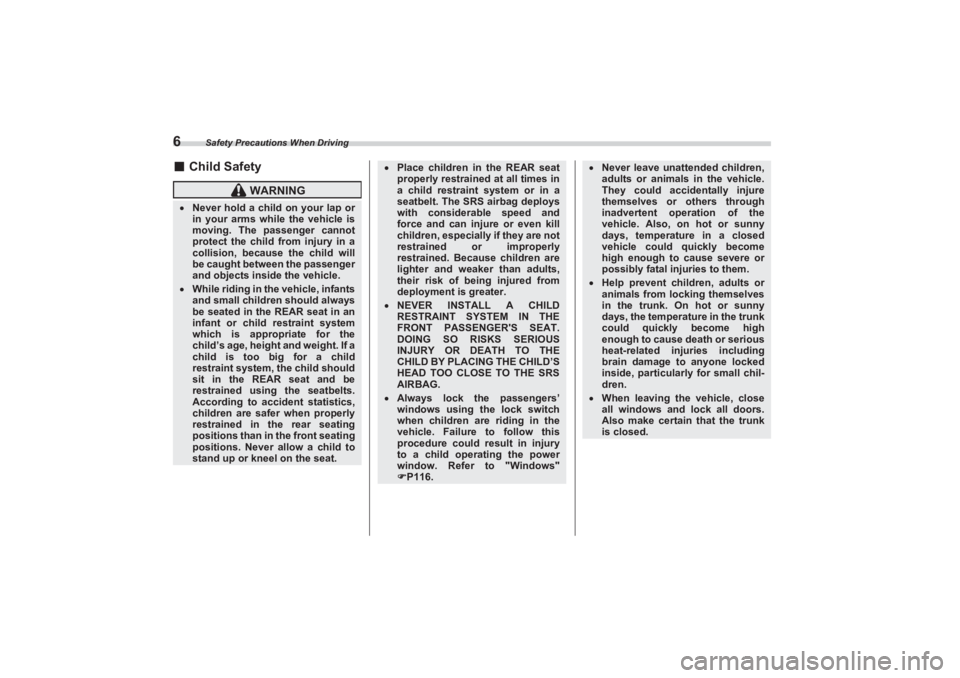
Safety Precautions When Driving
6■Child Safety
WARNING
Never hold a child on your lap or
in your arms while the vehicle is
moving. The passenger cannot
protect the child from injury in a
collision, because the child will
be caught between the passenger
and objects inside the vehicle. While riding in th e vehicle, infants
and small children should always
be seated in the REAR seat in an
infant or child restraint system
which is appropriate for the
child’s age, height and weight. If a
child is too big for a child
restraint system, the child should
sit in the REAR seat and be
restrained using the seatbelts.
According to accident statistics,
children are safer when properly
restrained in the rear seating
positions than in the front seating
positions. Never allow a child to
stand up or kneel on the seat.
Place children in the REAR seat
properly restrained at all times in
a child restraint system or in a
seatbelt. The SRS airbag deploys
with considerable speed and
force and can injure or even kill
children, especially if they are not
restrained or improperly
restrained. Because children are
lighter and weaker than adults,
their risk of being injured from
deployment is greater. NEVER INSTALL A CHILD
RESTRAINT SYSTEM IN THE
FRONT PASSENGER'S SEAT.
DOING SO RISKS SERIOUS
INJURY OR DEATH TO THE
CHILD BY PLACING THE CHILD’S
HEAD TOO CLOSE TO THE SRS
AIRBAG. Always lock the passengers’
windows using the lock switch
when children are riding in the
vehicle. Failure to follow this
procedure could result in injury
to a child operating the power
window. Refer to "Windows"
P116.
Never leave unattended children,
adults or animals in the vehicle.
They could accidentally injure
themselves or others through
inadvertent operation of the
vehicle. Also, on hot or sunny
days, temperature in a closed
vehicle could quickly become
high enough to cause severe or
possibly fatal injuries to them. Help prevent children, adults or
animals from locking themselves
in the trunk. On hot or sunny
days, the temperature in the trunk
could quickly become high
enough to cause death or serious
heat-related injuries including
brain damage to anyone locked
inside, particularly for small chil-
dren. When leaving the vehicle, close
all windows and lock all doors.
Also make certain that the trunk
is closed.
BRZ_U.book 6 ページ 2022年3月29日 火曜日 午後3時59分
Page 13 of 432

Safety Precautions When Driving
7
Introduction
– CONTINUED –
For instructions and precautions, carefully
read the following sections.
For the seatbelt system, refer to "Seat-
belts" P39.
For the child restraint system, refer to
"Child Restraint Systems" P46.
For the SRS airbag system, refer to
"SRS Airbag (Supplemental Restraint
System Airbag)" P60.
■ Engine Exhaust Gas (Carbon
Monoxide)
■Drinking and Driving
Put children aged 12 and under or
1.5 m (4 feet 11 inches) tall or less
in the REAR seat properly
restrained at all times in a child
restraint system or in a seatbelt.
The SRS airbag deploys with
considerable speed and force
and can injure or even kill chil-
dren, especially if they are 12
years of age and under or 1.5 m (4
feet 11 inches) tall or less and are
not restrained or improperly
restrained. Because children are
lighter and weaker than adults,
their risk of being injured from
deployment is greater.
WARNING
Never inhale engine exhaust gas.
Engine exhaust gas contains
carbon monoxide, a colorless
and odorless gas which is
dangerous, or even lethal, if
inhaled. Always properly maintain the
engine exhaust system to prevent
engine exhaust gas from entering
the vehicle. Never run the engine in a closed
space, such as a garage, except
for the brief time needed to drive
the vehicle in or out of it. Avoid remaining in a parked
vehicle for a long time while the
engine is running. If that is
unavoidable, then use the ventila-
tion fan to force fresh air into the
vehicle. Always keep the front ventilator
inlet grille free from snow, leaves
or other obstructions to ensure
that the ventilation system
always works properly.
If at any time you suspect that
exhaust fumes are entering the
vehicle, have the problem
checked and corrected as soon
as possible. If you must drive
under these conditions, drive
only with all windows fully open. Keep the trunk lid closed while
driving to prevent exhaust gas
from entering the vehicle.
WARNING
Drinking and then driving is very
dangerous. Alcohol in the blood-
stream delays your reaction and
impairs your perception, judgment
and attentiveness. If you drive after
drinking even if you drink just a lit-
tle it will increase the risk of being
involved in a serious or fatal acci-
dent, injuring or killing yourself,
your passengers and others. In
addition, if you are injured in the
accident, alcohol may increase the
severity of that injury.Please don’t drink and drive.
BRZ_U.book 7 ページ 2022年3月29日 火曜日 午後3時59分
Page 19 of 432
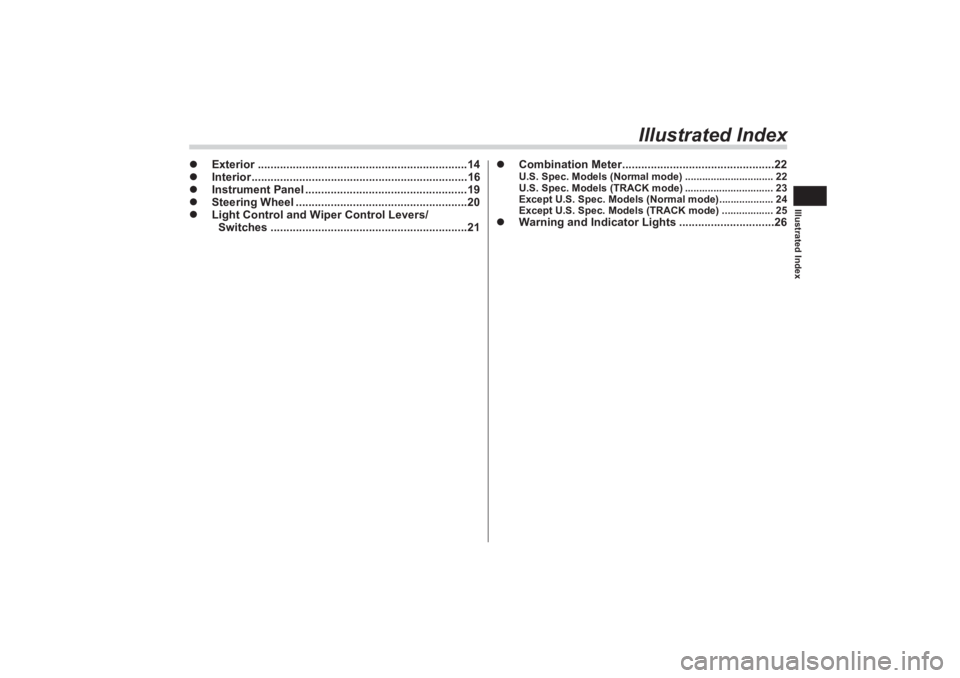
Illustrated Index
Illustrated Index
Exterior ..................................................................14
Interior ....................................................................16
Instrument Panel ...................................................19
Steering Wheel ......................................................20
Light Control and Wiper Control Levers/
Switches ..............................................................21
Combination Meter................................................22
U.S. Spec. Models (Normal mode) ............................... 22
U.S. Spec. Models (TRACK mo de) ............................... 23
Except U.S. Spec. Models (Normal mode)................... 24
Except U.S. Spec. Models (TRACK mode) . ................. 25
Warning and Indicator Lights ..............................26
BRZ_U.book 13 ページ 2022年3月29日 火曜日 午後3時59分
Page 32 of 432
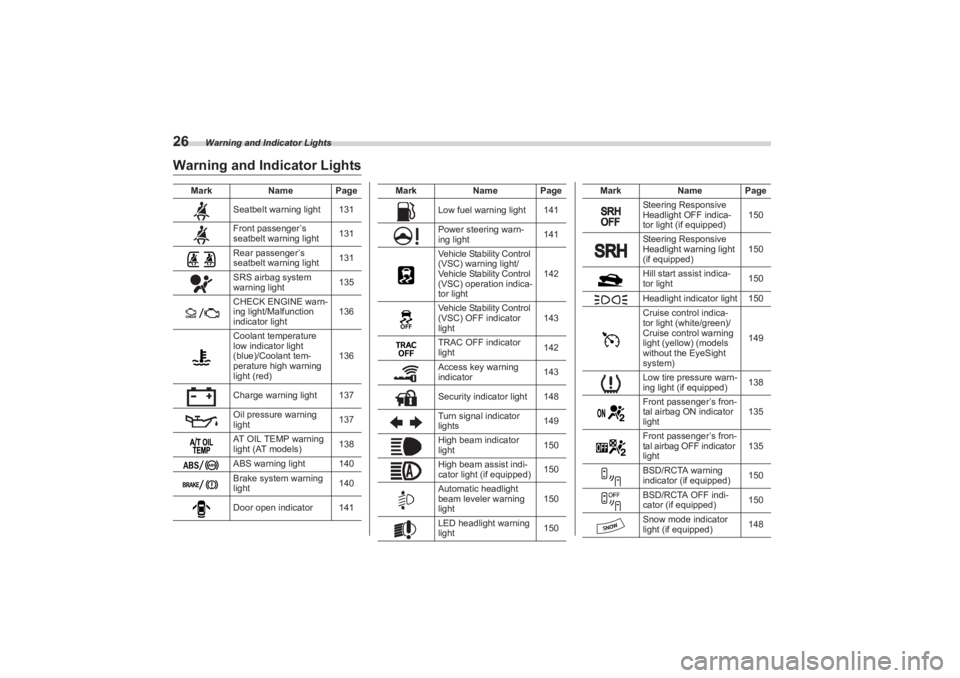
Warning and Indicator Lights
26
MarkName Page
Seatbelt warning light 131
Front passenger’s
seatbelt warning light 131
Rear passenger’s
seatbelt warning light 131
SRS airbag system
warning light 135
CHECK ENGINE warn-
ing light/Malfunction
indicator light 136
Coolant temperature
low indicator light
(blue)/Coolant tem-
perature high warning
light (red) 136
Charge warning light 137
Oil pressure warning
light 137
AT OIL TEMP warning
light (AT models) 138
ABS warning light 140
Brake system warning
light 140
Door open indicator 141
Low fuel warning light 141
Power steering warn-
ing light 141
Vehicle Stability Control
(VSC) warning light/
Vehicle Stability Control
(VSC) operation indica-
tor light 142
Vehicle Stability Control
(VSC) OFF indicator
light 143
TRAC OFF indicator
light 142
Access key warning
indicator 143
Security indicator light 148
Turn signal indicator
lights 149
High beam indicator
light 150
High beam assist indi-
cator light (if equipped) 150
Automatic headlight
beam leveler warning
light 150
LED headlight warning
light 150
Mark
Name Page
Steering Responsive
Headlight OFF indica-
tor light (if equipped) 150
Steering Responsive
Headlight warning light
(if equipped) 150
Hill start assist indica-
tor light 150
Headlight indicator light 150
Cruise control indica-
tor light (white/green)/
Cruise control warning
light (yellow) (models
without the EyeSight
system) 149
Low tire pressure warn-
ing light (if equipped) 138
Front passenger’s fron-
tal airbag ON indicator
light 135
Front passenger’s fron-
tal airbag OFF indicator
light 135
BSD/RCTA warning
indicator (if equipped) 150
BSD/RCTA OFF indi-
cator (if equipped) 150
Snow mode indicator
light (if equipped) 148
Mark
Name Page
Warning and Indicator LightsBRZ_U.book 26 ページ 2022年3月29日 火曜日 午後3時59分
Page 33 of 432

Warning and Indicator Lights
27
Illustrated Index
Sport mode indicator
light (if equipped)148
TRACK mode indica-
tor light 250
Icy road surface warn-
ing indicator 151
RAB warning indicator
(if equipped) 151
RAB OFF indicator (if
equipped) 151
Master warning light 151
Mark
Name Page
BRZ_U.book 27 ページ 2022年3月29日 火曜日 午後3時59分
Page 35 of 432
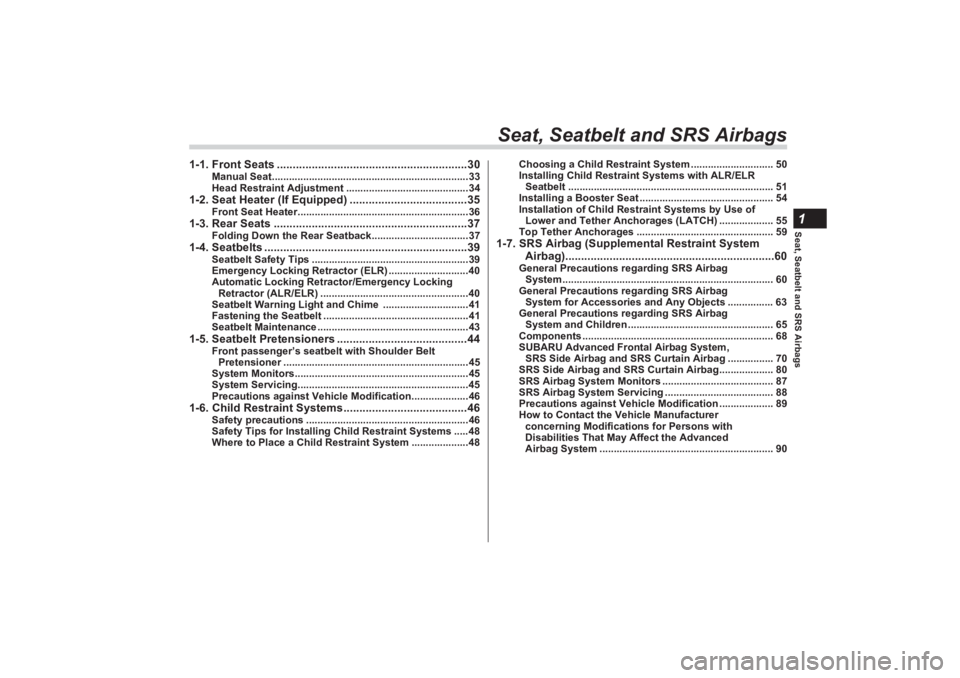
Seat, Seatbelt and SRS Airbags1
Seat, Seatbelt and SRS Airbags
1-1. Front Seats ............................................................30
Manual Seat.....................................................................33
Head Restraint Adjustment ...........................................34
1-2. Seat Heater (If Equipped) .....................................35
Front Seat Heater............................................................36
1-3. Rear Seats .............................................................37
Folding Down the Rear Seatback..................................37
1-4. Seatbelts ................................................................39
Seatbelt Safety Tips .......................................................39
Emergency Locking Retractor (ELR) ............................40
Automatic Locking Retractor/Emergency Locking Retractor (ALR/ELR) .............. ......................................40
Seatbelt Warning Light and Chime ..............................41
Fastening the Seatbelt ...................................................41
Seatbelt Maintenance .....................................................43
1-5. Seatbelt Pretensioners .........................................44
Front passenger’s seatbelt with Shoulder Belt Pretensioner .................................................................45
System Monitors.............................................................45
System Servicing................... .........................................45
Precautions against Vehicle Modification....................46
1-6. Child Restraint System s.......................................46
Safety precautions .........................................................46
Safety Tips for Installing Child Restraint Systems .....48
Where to Place a Child Restraint System ....................48 Choosing a Child Restraint System ............................. 50
Installing Child Restraint Systems with ALR/ELR
Seatbelt ........................................................................ 51
Installing a Booster Seat ............................................... 54
Installation of Child Rest raint Systems by Use of
Lower and Tether Anchorages (LATCH) ................... 55
Top Tether Anchorages ................................................ 59
1-7. SRS Airbag (Supplemental Restraint System
Airbag)..................................................................60
General Precautions regarding SRS Airbag
System.......................................................................... 60
General Precautions regarding SRS Airbag
System for Accessories and Any Objects ................ 63
General Precautions regarding SRS Airbag
System and Children ................................................... 65
Components ................................................................... 68
SUBARU Advanced Frontal Airbag System,
SRS Side Airbag and SRS Curtain Airbag ................ 70
SRS Side Airbag and SRS Curtain Airbag................... 80
SRS Airbag System Monitors ....................................... 87
SRS Airbag System Servicing . ..................................... 88
Precautions against Vehicle Modification ................... 89
How to Contact the Vehicle Manufacturer
concerning Modifications for Persons with
Disabilities That May Affect the Advanced
Airbag System ............................................................. 90
BRZ_U.book 29 ページ 2022年3月29日 火曜日 午後3時59分
Page 37 of 432
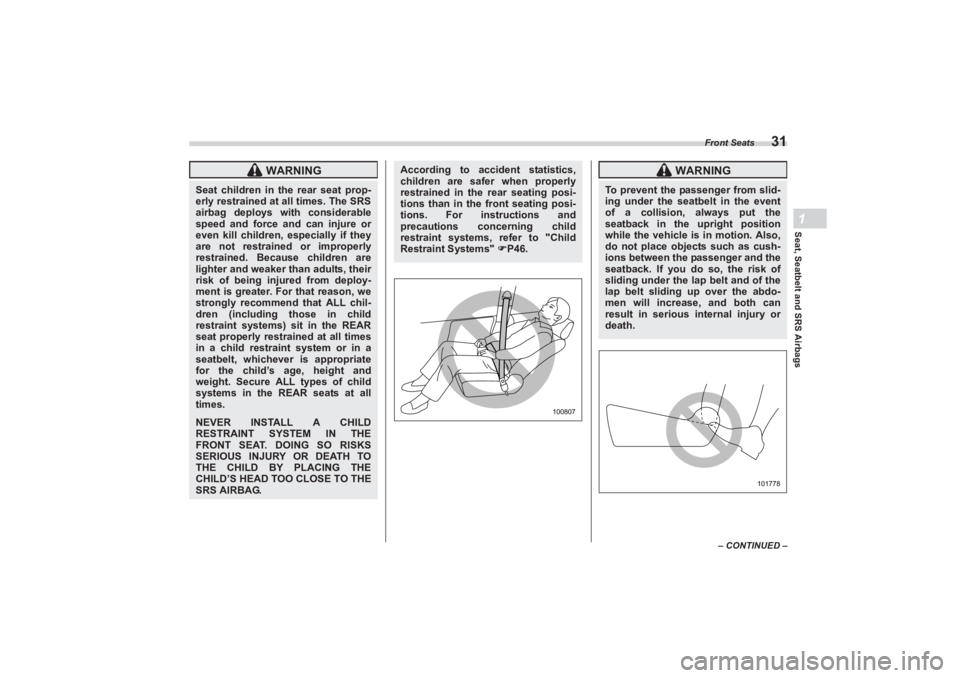
Front Seats
31
Seat, Seatbelt and SRS Airbags1
– CONTINUED –
WARNING
Seat children in the rear seat prop-
erly restrained at all times. The SRS
airbag deploys with considerable
speed and force and can injure or
even kill children, especially if they
are not restrained or improperly
restrained. Because children are
lighter and weaker than adults, their
risk of being injured from deploy-
ment is greater. For that reason, we
strongly recommend that ALL chil-
dren (including those in child
restraint systems) sit in the REAR
seat properly restrained at all times
in a child restraint system or in a
seatbelt, whichever is appropriate
for the child’s age, height and
weight. Secure ALL types of child
systems in the REAR seats at all
times.NEVER INSTALL A CHILD
RESTRAINT SYSTEM IN THE
FRONT SEAT. DOING SO RISKS
SERIOUS INJURY OR DEATH TO
THE CHILD BY PLACING THE
CHILD’S HEAD TOO CLOSE TO THE
SRS AIRBAG.
According to accident statistics,
children are safer when properly
restrained in the rear seating posi-
tions than in the front seating posi-
tions. For instructions and
precautions concerning child
restraint systems, refer to "Child
Restraint Systems" P46.
100807
WARNING
To prevent the passenger from slid-
ing under the seatbelt in the event
of a collision, always put the
seatback in the upright position
while the vehicle is in motion. Also,
do not place objects such as cush-
ions between the passenger and the
seatback. If you do so, the risk of
sliding under the lap belt and of the
lap belt sliding up over the abdo-
men will increase, and both can
result in serious internal injury or
death.
101778
BRZ_U.book 31 ページ 2022年3月29日 火曜日 午後3時59分